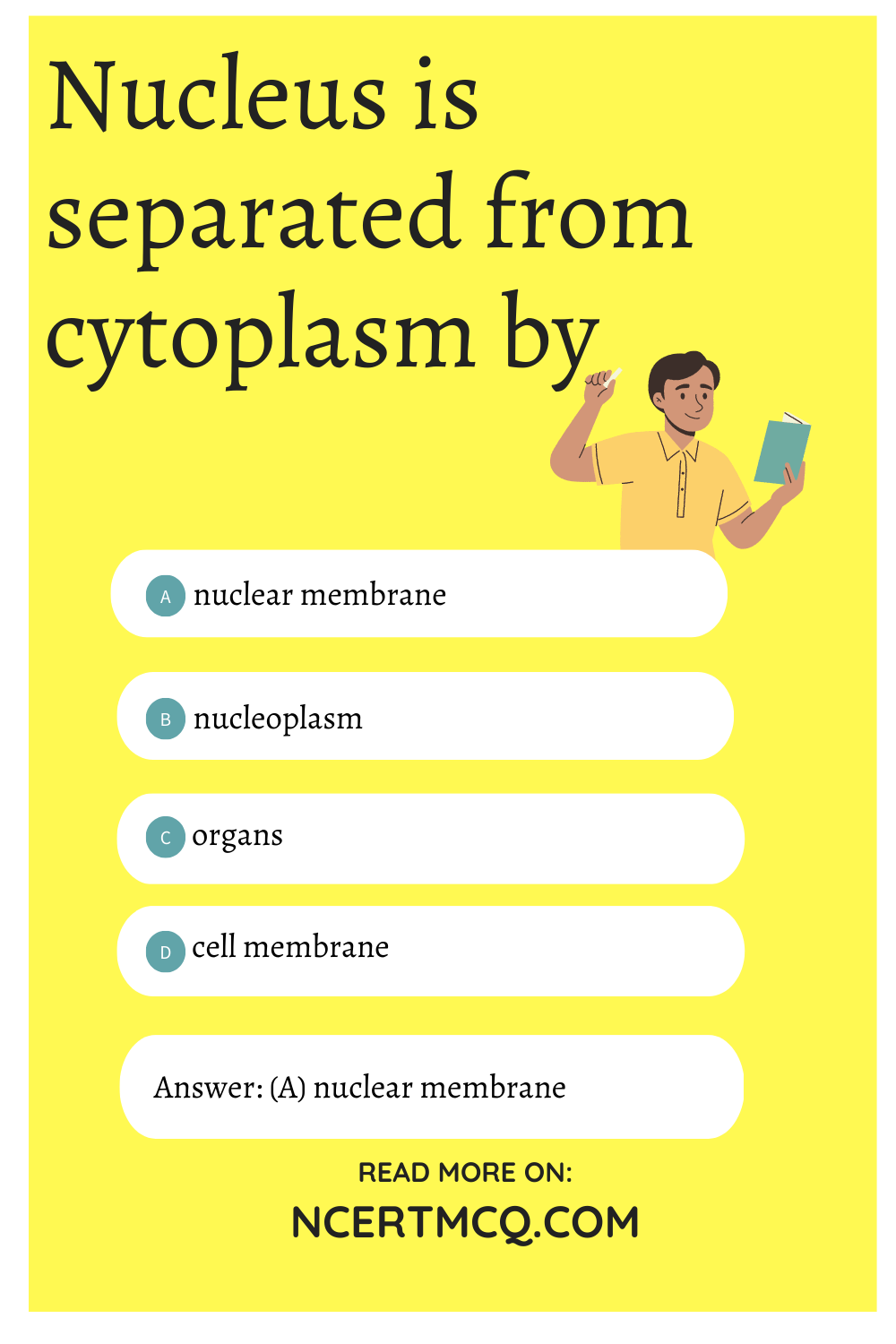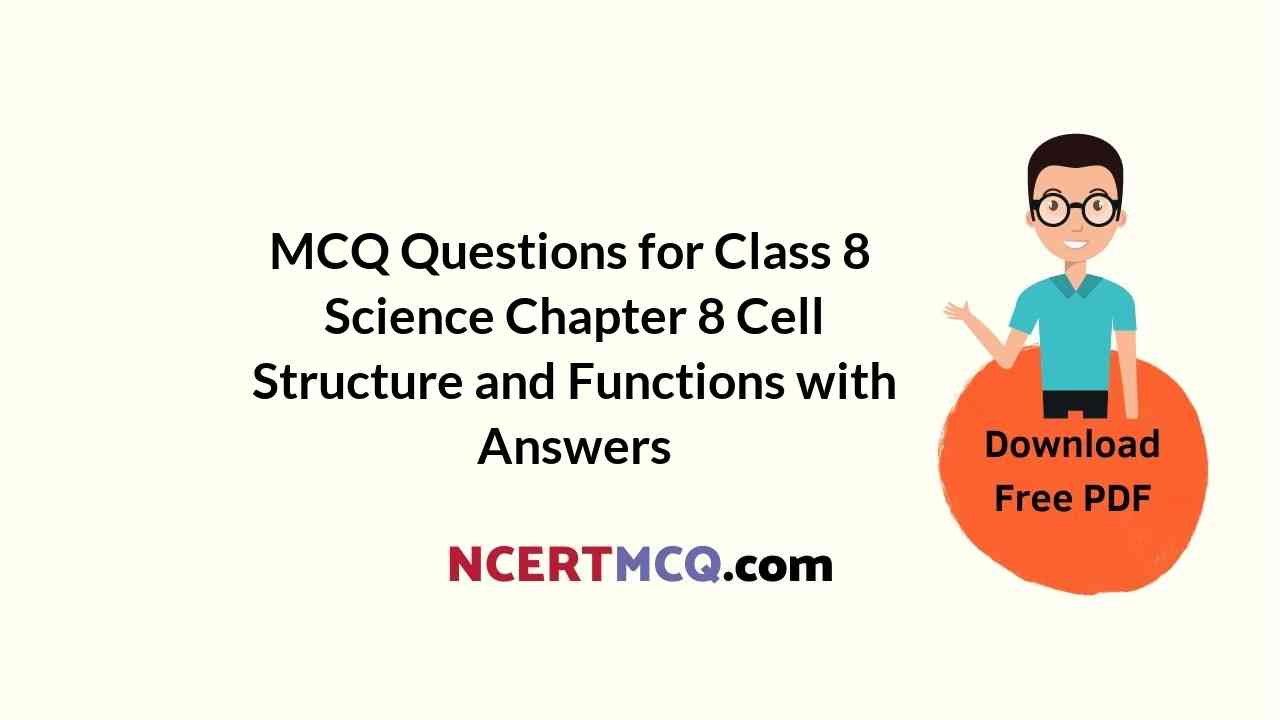Check the below Online Education NCERT MCQ Questions for Class 8 Science Chapter 8 Cell Structure and Functions with Answers Pdf free download. MCQ Questions for Class 8 Science with Answers were prepared based on the latest exam pattern. We have provided Cell Structure and Functions Class 8 Science MCQs Questions with Answers to help students understand the concept very well. https://ncertmcq.com/mcq-questions-for-class-8-science-with-answers/
You can refer to NCERT Solutions for Class 8 Science Chapter 8 Cell Structure and Functions to revise the concepts in the syllabus effectively and improve your chances of securing high marks in your board exams.
Class 8 Science Chapter 8 MCQ With Answers
Science Class 8 Chapter 8 MCQs On Cell Structure and Functions
Choose the correct option.
Class 8 Science Chapter 8 MCQ Question 1.
Nucleus is separated from cytoplasm by
(a) nuclear membrane
(b) nucleoplasm
(c) organs
(d) cell membrane
Answer
Answer: (a) nuclear membrane

Cell Structure And Function Class 8 MCQ Question 2.
The liquid material in the nucleus is
(a) chromosomes
(b) bacteria
(c) nucleoplasm
(d) nucleolus
Answer
Answer: (c) nucleoplasm
Class 8 Science Ch 8 MCQ Question 3.
Tissues combine to form
(a) nucleus
(b) cells
(c) organism
(d) organs
Answer
Answer: (d) organs
MCQ Questions For Class 8 Science Chapter 8 Question 4.
Cells present in living organism differ in
(a) numbers
(b) shape
(c) size
(d) all of these
Answer
Answer: (d) all of these
Class 8 Chapter 8 Science MCQ Question 5.
Cells which lack nuclear membrane are
(a) eukaryotic cells
(b) prokaryotic cells
(c) single cells
(d) multicells
Answer
Answer: (b) prokaryotic cells
Ncert Class 8 Science Chapter 8 MCQ Question 6.
The control centre of all the activities of a cell is
(a) nucleus
(b) nucleoplasm
(c) cytoplasm
(d) organelles
Answer
Answer: (a) nucleus
Class 8 Cell Structure And Function MCQ Question 7.
The coloured organelles which are found in plants only are
(a) chlorophyll
(b) plastids
(c) vacuoles
(d) WBC
Answer
Answer: (b) plastids
Cell Structure And Function MCQ Question 8.
Genes are located in
(a) chrpmosomes
(b) plastids
(c) cytoplasm
(d) lysosome
Answer
Answer: (a) chrpmosomes
Class 8 Ch 8 Science MCQ Question 9.
A group of similar cells combine to form
(a) tissue
(b) organ
(c) organisms
(d) organelles
Answer
Answer: (a) tissue
Ch 8 Science Class 8 MCQ Question 10.
The organism containing only a single cell is called
(a) unicellular organism
(b) multicellular organism
(c) organelle
(d) all of these
Answer
Answer: (a) unicellular organism
Chapter 8 Science Class 8 MCQ Question 11.
Cell walls is found in
(a) plant cells only
(b) animal cells only
(c) both (a) and (b)
(d) none of them
Answer
Answer: (a) plant cells only
Science Class 8 Chapter 8 MCQ Question 12.
The empty blank looking structures in the cytoplasm is
(a) vacuoles
(b) plastids
(c) plasma membrane
(d) nucleus
Answer
Answer: (a) vacuoles
Class 8th Science Chapter 8 MCQ Question 13.
The other name of cell membrane is
(a) plasma membrane
(b) cell wall
(c) nuclear membrane
(d) none of these
Answer
Answer: (a) plasma membrane
Class 8 Science Chapter 8 MCQs Question 14.
The basic structural and functional unit of all living organism is
(a) cell
(b) cell wall
(c) cell membrane
(d) chloroplasts
Answer
Answer: (a) cell
MCQ Cell Structure And Function Class 8 Question 15.
Chromosomes are found in
(a) nucleus
(b) nucleolus
(c) nucleoplast
(d) vacuole
Answer
Answer: (a) nucleus

Match the items given in column I suitably with those given in column II
| Column I | Column II |
| 1. Mitochondria | (a) Cell |
| 2. Functional unit of life | (b) Nucleus |
| 3. Control unit of cell | (c) Unicellular |
| 4. Single-celled organism | (d) Discovery of cell |
| 5. Robert Hooke | (e) Power house of a cell |
| 6. Combination of tissues | (f) Transfers messages |
| 7. Cytoplasm | (g) Jelly-like substance |
| 8. Nerve cell | (h) Forms organ |
| 9. Living substance in the cell | (i) Cell wall |
| 10. Outermost thick layer in plant cells | (j) Protoplasm |
Answer
Answer:
| Column I | Column II |
| 1. Mitochondria | (e) Power house of a cell |
| 2. Functional unit of life | (a) Cell |
| 3. Control unit of cell | (b) Nucleus |
| 4. Single-celled organism | (c) Unicellular |
| 5. Robert Hooke | (d) Discovery of cell |
| 6. Combination of tissues | (h) Forms organ |
| 7. Cytoplasm | (g) Jelly-like substance |
| 8. Nerve cell | (f) Transfers messages |
| 9. Living substance in the cell | (j) Protoplasm |
| 10. Outermost thick layer in plant cells | (i) Cell wall |
Fill in the blanks with suitable word/s.
1. Cells are the __________ unit of all living organisms.
Answer
Answer: basic
2. __________ cells are branched.
Answer
Answer: Muscle
3. Amoeba has __________ shape.
Answer
Answer: irregular
4. The __________ cell transfers the messages.
Answer
Answer: nerve
5. __________ is a group of tissues.
Answer
Answer: Organ
6. Protoplasm is __________ inside the cell.
Answer
Answer: viscous fluid
7. Eukaryotes cells have a well-developed __________.
Answer
Answer: nucleus
8. The jelly-like substance found between the nucleus and the cell-membrane is __________
Answer
Answer: cytoplasm
9. Nucleus is separated from the cytoplasm by __________.
Answer
Answer: nuclear membrane
10. An __________ is a group of organs.
Answer
Answer: organ system
11. __________ are present in plant cells but in animal cells.
Answer
Answer: Plastids, absent
12. __________ is the process of making food in plants.
Answer
Answer: Photosynthesis
13. __________ is absent in animal cell.
Answer
Answer: Cell wall
14. The kitchen of plant cell is __________.
Answer
Answer: plastid
15. __________ is the power house of the cell.
Answer
Answer: Mitochondria
State whether the given statements are true or false.
1. Cytoplasm is not a part of cell.
Answer
Answer: False
2. Cell wall surrounds the cell membrane.
Answer
Answer: True
3. A group of similar cells is called tissue.
Answer
Answer: True
4. Tissues combine to form an organism.
Answer
Answer: False
5. Cell are of different sizes.
Answer
Answer: True
6. Chloroplasts are blue in colour.
Answer
Answer: False
7. Plastid occur in plant cells only.
Answer
Answer: True
8. Chromosomes contain basic hereditary units called genes.
Answer
Answer: True
9. Nucleus is the control unit of cell.
Answer
Answer: True
10. The shape and size of cell is related to its function.
Answer
Answer: True
11. Organs make up tissues.
Answer
Answer: False
12. The cytoplasm and nucleoplasm make up the protoplasm.
Answer
Answer: True
13. The smallest unit of life is chloroplast.
Answer
Answer: False
14. Unicellular organisms have one-celled body.
Answer
Answer: True
15. The cell wall is living in nature.
Answer
Answer: False
We hope the given NCERT MCQ Questions for Class 8 Science Chapter 8 Cell Structure and Functions with Answers Pdf free download will help you. If you have any queries regarding Cell Structure and Functions CBSE Class 8 Science MCQs Multiple Choice Questions with Answers, drop a comment below and we will get back to you soon.
Class 8 Science MCQ:
- Crop Production and Management Class 8 MCQ
- Microorganisms: Friend and Foe Class 8 MCQ
- Synthetic Fibres and Plastics Class 8 MCQ
- Materials: Metals and Non-Metals Class 8 MCQ
- Coal and Petroleum Class 8 MCQ
- Combustion and Flame Class 8 MCQ
- Conservation of Plants and Animals Class 8 MCQ
- Cell Structure and Functions Class 8 MCQ
- Reproduction in Animals Class 8 MCQ
- Reaching the Age of Adolescence Class 8 MCQ
- Force and Pressure Class 8 MCQ
- Friction Class 8 MCQ
- Sound Class 8 MCQ
- Chemical Effects of Electric Current Class 8 MCQ
- Some Natural Phenomena Class 8 MCQ
- Light Class 8 MCQ
- Stars and the Solar System Class 8 MCQ
- Pollution of Air and Water Class 8 MCQ
